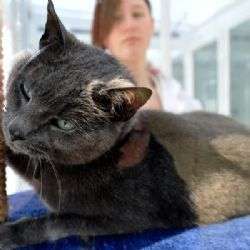A study into cat ownership looks at whether people who own an excessive number of cats are on the slippery slope to becoming animal hoarders.
The research investigated whether owners of 20 or more cats were more likely to share the often detrimental psychological and demographic profile of animal hoarders, compared to owners of one or two cats.
Dr Sarah Ellis, from the University of Lincoln's School of Life Sciences, was a co-author on the paper which was published in Human-Animal Interaction Bulletin.
Dr Ellis said: "Previous research in the area of animal hoarding has concentrated around extreme cases where authorities have often been alerted of the owners hoarding problem. By this stage, hoarding behaviour is well developed and therefore our ability to understand the development of hoarding behaviours from such research is limited. However, by virtue of the elusive and secretive nature of animal hoarders, identifying the early stages is often difficult so research is scarce. Our study used validated psychometric scales for traits previously reported to be associated with animal hoarding such as anxiety, depression and attachment in addition to a saving inventory used to measure hoarding behaviour in object hoarding. We wanted to find out whether owners of large number of cats were more closely aligned to clinical animal hoarders or more typical cat owners on such measures."
Pet ownership varies from owners who exhibit typical, healthy relationships with one or relatively few animals – where the needs of both owner and animals are met – to highly dysfunctional clinical cases of animal hoarding, where excessive numbers of animals are owned and both animal and human welfare are severely compromised.
Animal hoarding is a spectrum-based condition in which hoarders are often reported to have had normal and appropriate pet-keeping habits in childhood and early adulthood.
Historically, research has focused largely on well-established clinical animal hoarders with little work targeted towards the onset and development of animal hoarding. This project aimed to fill the knowledge gap.
The study, which was carried out with the University of São Paulo, Brazil took the sample pet owners from a Brazilian population as the ownership of large numbers of animals, particularly cats, is relatively common.
For the first time, it was shown that owners of large numbers of cats differ significantly from owners of one or two cats when considering a range of clinical scales related to hoarding. They were significantly older and more attached to their cats, as well as displaying a relationship between hoarding behaviour and anxiety that was not witnessed in owners of one or two cats.
Hoarders are deeply attached to their pets and find it extremely difficult to let go, not being able to comprehend they are harming their pets by failing to care for them properly.
Dr Ellis said: "The results of this research suggest owners of large numbers of cats may be closer to the end of the pet keeping spectrum that represents animal hoarding than the end that represents appropriate and healthy pet keeping. Therefore, the studied population may represent the understudied group of early stage animal hoarders. However, external factors such as culture and societal animal control policies should not be overlooked as alternative explanations for pet keeping at levels that might be considered excessive, particularly within this population where opportunity to take unwanted animals to rescue centres is limited."
Dr Daniela Ramos, lead researcher from the University of São Paulo and former Research Fellow at the University of Lincoln, added: "Owners of large numbers of cats are common in Brazil and are frequently seen by vets working in feline specialised practices. Recognising that several of them, particularly the ones who still care for the animals thus taking them to veterinary clinics, are likely to be at early stages of hoarding, points to the important role vets can play by helping their animals while contributing to the prevention of hoarding. At this early stage it may be possible to help by education rather than intervention."
Provided by University of Lincoln


















